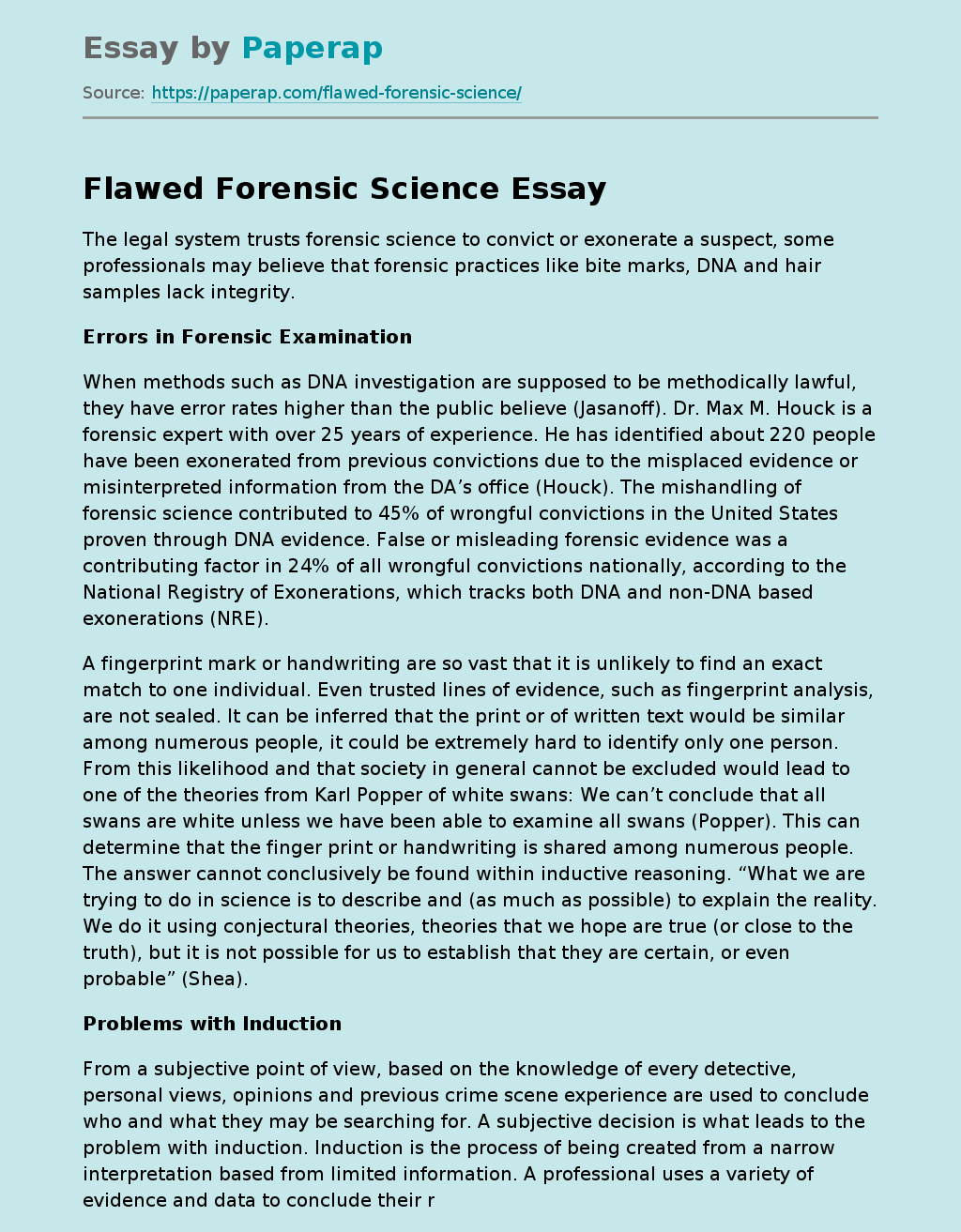Flawed Forensic Science
The legal system trusts forensic science to convict or exonerate a suspect, some professionals may believe that forensic practices like bite marks, DNA and hair samples lack integrity.
Errors in Forensic Examination
When methods such as DNA investigation are supposed to be methodically lawful, they have error rates higher than the public believe (Jasanoff). Dr. Max M. Houck is a forensic expert with over 25 years of experience. He has identified about 220 people have been exonerated from previous convictions due to the misplaced evidence or misinterpreted information from the DA’s office (Houck).
The mishandling of forensic science contributed to 45% of wrongful convictions in the United States proven through DNA evidence. False or misleading forensic evidence was a contributing factor in 24% of all wrongful convictions nationally, according to the National Registry of Exonerations, which tracks both DNA and non-DNA based exonerations (NRE).
A fingerprint mark or handwriting are so vast that it is unlikely to find an exact match to one individual.
Even trusted lines of evidence, such as fingerprint analysis, are not sealed. It can be inferred that the print or of written text would be similar among numerous people, it could be extremely hard to identify only one person. From this likelihood and that society in general cannot be excluded would lead to one of the theories from Karl Popper of white swans: We can’t conclude that all swans are white unless we have been able to examine all swans (Popper). This can determine that the finger print or handwriting is shared among numerous people.
The answer cannot conclusively be found within inductive reasoning. “What we are trying to do in science is to describe and (as much as possible) to explain the reality. We do it using conjectural theories, theories that we hope are true (or close to the truth), but it is not possible for us to establish that they are certain, or even probable” (Shea).
Problems with Induction
From a subjective point of view, based on the knowledge of every detective, personal views, opinions and previous crime scene experience are used to conclude who and what they may be searching for. A subjective decision is what leads to the problem with induction. Induction is the process of being created from a narrow interpretation based from limited information. A professional uses a variety of evidence and data to conclude their results. There are no standards to guide how professionals reach their conclusions. If there is no standard to go by then it is completely up to the decision of the individual examiner to reach a conclusion and run with it. If the print is wrong, the detective can associate a few shared impressions to prove it is an exact match. This is basically subjective that leads to a biased conclusion. (Mnookin).
In an attempt to overcome the induction problem in traditional forensics, it is trusted that differences between numerous features and an objective approach to let hard evidence do the heavy lifting. For example, firearms results use deductive reasoning skills in scientific investigations. Deductive reasoning applies philosophies to predict precise answers. A certain make will leave the same markers on a bullet. The type of weapon could then be identified (Mnookin). Traditional forensic sciences need to change the current paradigm. The current central staple of these fields is deteriorated by evidence of errors in proficiency testing. Changes in the law pertaining to the acceptability of expert evidence are driving the older forensic sciences toward a new scientific paradigm. Although forensic science is still flawed, these sciences are moving toward a new scientific paradigm (Jasanoff).
Thomas Kuhn’s Concept
From Thomas Kuhn’s concept there are the five characterizes to prove a theory is valid. They are accuracy, consistency, scope, simplicity and fruitfulness (95). Forensic science can fit within accuracy because at the time of court cases and evidence built up against the perp, it is through the current scientific experiments and observations that come to the conclusion. The accuracy of forensics science paradigm is always being shifted to something different when new equipment comes out and new research is found. It can also fit within consistency in that it fits with Karl popper’s theory of white swans and how a fingerprint cannot be reduced to one individual. Forensic science can as well be fruitful, the parameters are constantly changing to advance with technology and use everything at hand to merge what they already know to the new theories being added within the science. Forensics is converting the science to be more grounded and improve with technology.
What’s needed are additional safeguards to shield forensic examiners against inappropriate information that can skew their judgement. There needs to be an improvement within the justice system to rethink its leaning to disclose pattern matching evidence. Improving laws to ensure proper access to release evidence based on changes in science for people who have been convicted based off of biased or mishandled evidence. Some states have already taken measures to help improve the justice system. California enacted a law that allows convicted people to seek relief based on flawed forensic evidence used in their convictions (NRE). Flawed convictions sometimes occur, new science and technology can help distinguish and correct future mistakes. If the people doing crime scene work are trained to believe evidence has a limited role and value, the more errors will occur. There is also a need for a judge to be versed in forensic science, a judge decides what evidence can be presented in court. Most of them do not have training within forensics or the skill to evaluate the logical legitimacy of forensic practice, this should be above the current precedent (Jasanoff).
References
- https://www.mitpressjournals.org/doi/full/10.1162/daed_a_00523 (Mnookin, 2018)
- https://www.youtube.com/watch?v=kXAk_frXOxI (Houck).
- https://www.mitpressjournals.org/doi/full/10.1162/daed_a_00517 (Jasanoff, 2018)
- https://www.iep.utm.edu/pop-sci/#SH2d (shea)
- https://www.innocenceproject.org/overturning-wrongful-convictions-involving-flawed-forensics/ (NRE)
Flawed Forensic Science. (2021, Dec 08). Retrieved from https://paperap.com/flawed-forensic-science/

